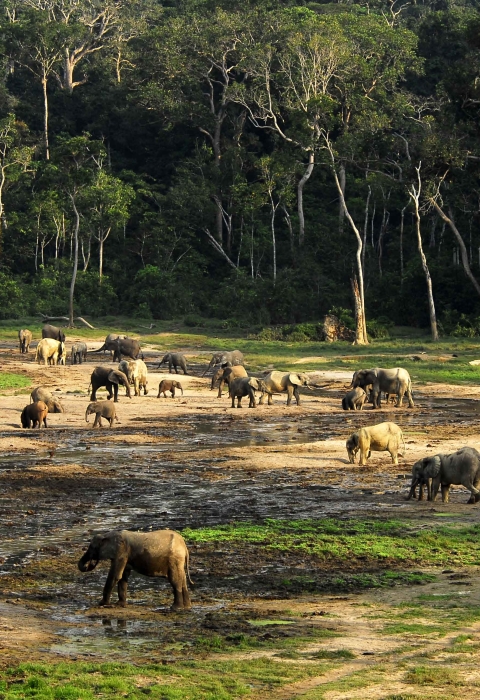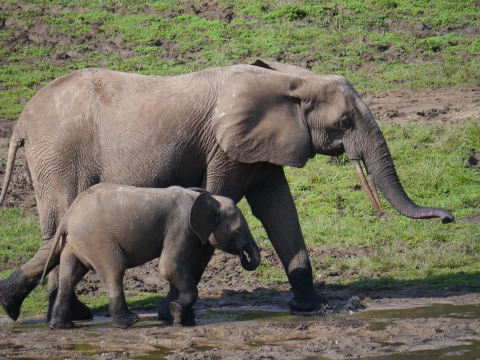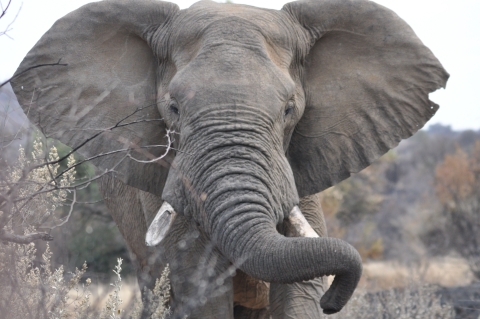Management and Conservation
African elephants (Genus: Loxodonta) once occurred throughout sub-Saharan Africa. During the sixteenth century, the African continent may have contained as many as 26 million elephants. However, by the start of the twentieth century, their numbers were reduced to 10 million. By 1989, a year after the U.S. Congress passed the African Elephant Conservation Act in response to the alarming decline of African elephant populations due to poaching for ivory and habitat loss, only 600,000 elephants remained. After a global moratorium was put in place restricting commercial trade in ivory, elephants had a period of stabilization in the 1990s in some countries.
Since then, a resurgence of illegal poaching of elephants in Africa, primarily for their ivory but also for meat and in retaliation for human-elephant conflict, is again resulting in the serious decline of both forest and savanna elephant populations. Even in some of Africa’s premiere parks, once thought to be safe havens, elephants are now under attack. Across Africa, an estimated 100,000 elephants were killed for their ivory between 2010 and 2012, and between 2011 and 2014, African elephant poaching levels reached the highest level recorded since international monitors began keeping detailed records in 2002. The continent-wide estimate for all elephants has now been revised downward to 415,000.
Despite some progress in halting and stabilizing the resurgence of elephant poaching since 2011, in some areas, Africa's elephants are still being poached at higher rates than they can naturally reproduce. In addition to the direct threat caused by poaching, the natural habitat of African elephants is shrinking as human populations grow and forests and savannas are cleared for infrastructure development, agriculture, and extractive industries such as logging and mining. Loss and degradation of habitat leaves elephants with a very limited food supply, which results in high levels of human-elephant conflict and retaliatory killings when hungry elephants enter villages and destroy local farmers’ crops.
In 2021, the African Elephant Specialist Group (AfESG) of the International Union for Conservation of Nature (IUCN) re-classified the African elephant as two separate species, with the forest elephant (Loxodonta cyclotis) now listed as “Critically Endangered” and the savanna elephant (Loxodonta africana) listed as “Endangered” under the IUCN’s 2020 African elephant Red List Assessment.
(*The African elephant taxonomy used by IUCN is not a legal authority for statutory or regulatory purposes.)
Through the African Elephant Conservation Fund, the U.S. Fish and Wildlife Service supports the 37 African elephant range states with financial support for essential protection activities, including anti-poaching patrols, applied research and monitoring, and mitigation of human-elephant conflict. For more information on current projects, please see our most recent project summaries. If you are interested in applying for funding, please visit our African Elephant Conservation Grant Fund page.
Central Africa
The forests of Central Africa have been particularly hard hit. The total population of forest elephants declined by 62 percent between 2002 and 2011. Researchers estimate that forest elephants have disappeared entirely from 30 percent of the area they occupied a decade earlier. These declines have been particularly devastating in the Democratic Republic of the Congo, where warfare, the proliferation of weapons, and trading in ivory to fuel rebel factions have resulted in the loss of 80 percent (80,000) of the country's elephants since 1970. Gabon, which is home to more than 50 percent of the world's remaining forest elephants, has also not been spared. Gabon's Minkébé National Park, bordering Cameroon and the Republic of the Congo, was once home to the highest densities of forest elephants in Central Africa. Over a recent ten-year period, approximately 80 percent (more than 25,000) of the elephants in this park were killed. The U.S. Fish and Wildlife Service's Central Africa Program has been working closely with Gabon's National Parks Agency (ANPN) to protect elephants and other wildlife, to strengthen the capacity of ANPN as a key partner in the region, and to ensure the political will necessary for long-term success. Central Africa is estimated to have 24,119 elephants, according to the IUCN AfESG 2016 African Elephant Status Report.
West Africa
West Africa has lost most of its elephants, with few isolated and fragmented populations exceeding 100 animals, and poaching levels remain high. The northernmost Mali desert elephants are at serious risk because of scarce resources, warfare, and rampant poaching in the absence of effective wildlife law enforcement. Local staff and residents had made significant progress to protect the elephants and their water sites, but this security has been undermined by recent instability. The transfrontier W-Arly-Pendjari Complex (Benin, Burkina Faso, and Niger), remains the region's largest elephant population with more than 4,000 elephants in the core protected areas. West Africa is estimated to have 11,489 elephants, according to the IUCN AfESG 2016 African Elephant Status Report.
East Africa
The future of elephants in East Africa is far from certain. As recently as 2008, Tanzania was home to the second largest population of elephants in Africa, with an estimated 110,000-165,000 individuals according to the IUCN AfESG’s African Elephant Database. However, by Tanzania’s own estimate, the country lost 60 percent of its elephants over a recent five-year period, dropping to a national total of 43,330. Its most significant population (in the Selous-Mikumi ecosystem) dropped from 70,000 in 2006 to 40,000 by 2009, and to a shocking 13,084 elephants in 2013 – a 66 percent loss in just three years. The next two largest populations also experienced catastrophic declines between 2009 and 2014: Ruaha-Rungwa dropped from 30,000 to 8,000 and Malagarasi-Moyowosi-Kigosi declined from 15,000 to 3,000. Since 2015, reports of reduced poaching levels in some parts of East Africa, including Kenya's Tsavo National Park, are encouraging and highlight what can be achieved through sustained and collective frontline efforts and political support. East Africa is estimated to have 86,373 elephants, according to the IUCN AfESG 2016 African Elephant Status Report.
Southern Africa
Since the early 1980s, Southern Africa has been the main stronghold and safe haven for savanna elephant populations. Through immigration and natural population growth, Africa’s largest elephant population, in northern Botswana, grew steadily from 80,000 in 1996 to 129,000 in 2014. But in recent years, Botswana has also been targeted by poachers, with regular reports of poached carcasses being found in Chobe and Moremi National Parks and surrounding areas. Recent estimates show the elephant population in Zimbabwe to be more than 80,000. Southern Africa is estimated to have 293,447 elephants, according to the IUCN AfESG 2016 African Elephant Status Report.



